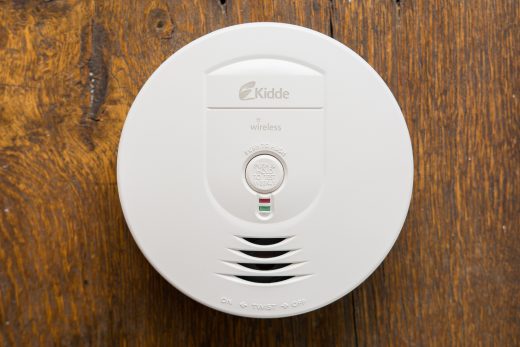The best basic smoke alarm
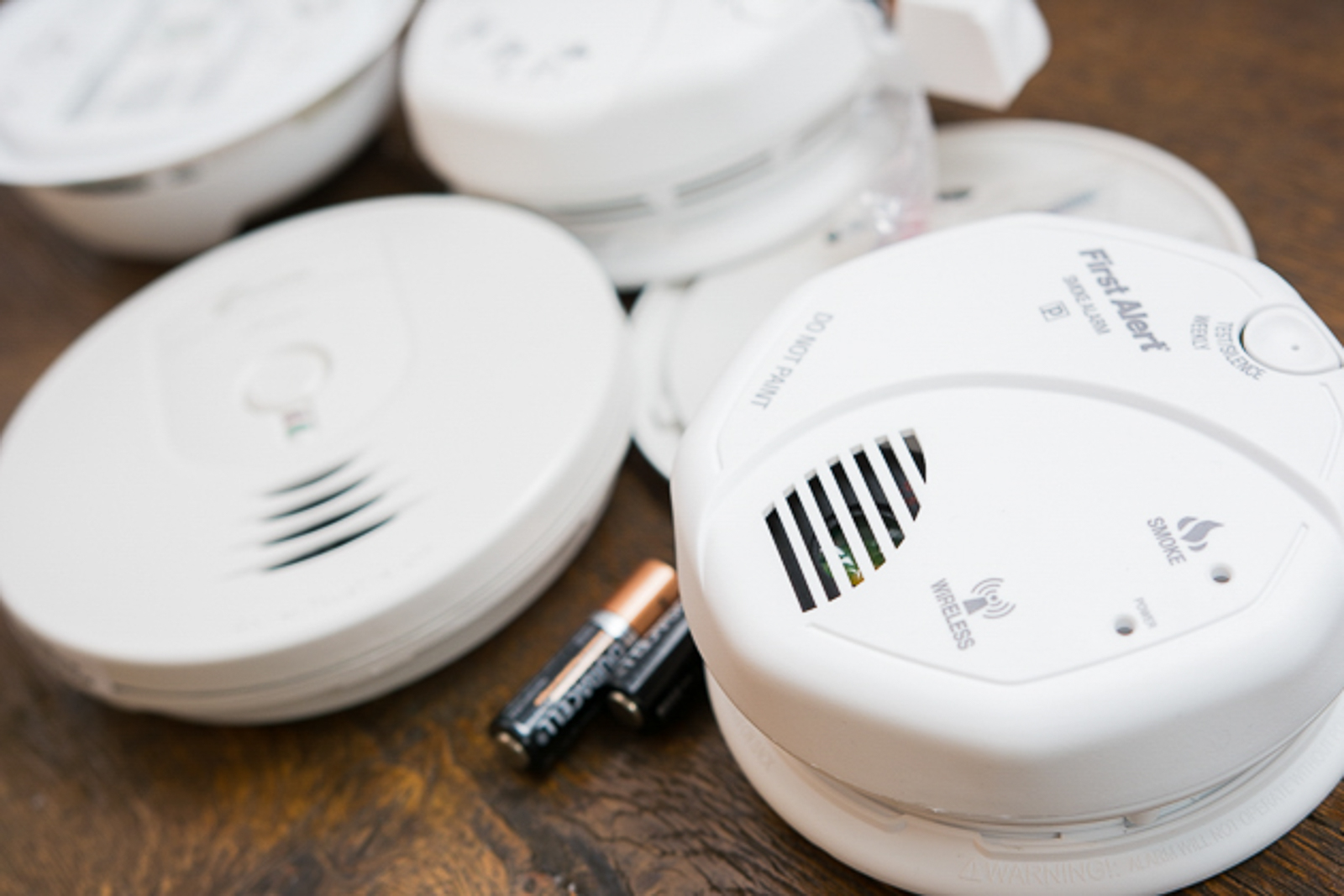
By Doug Mahoney
This post was done in partnership with Wirecutter. When readers choose to buy Wirecutter’s independently chosen editorial picks, it may earn affiliate commissions that support its work. Read the full article here.
After more than 65 hours researching fire safety, interviewing five experts, and reading well over a hundred pages of smoke-alarm data, we recommend the First Alert SA511CN2-3ST Smoke Alarm with Voice Location as the primary alarm in a comprehensive whole-home fire-protection system.
This UL-certified alarm comes in a two-pack, and the units (and any additional ones) can interconnect so that if one sounds, they all sound, which can give you additional time to identify the problem and evacuate. This wireless-connection setup is internal to the alarms and does not require a phone app. You can also designate each unit by location, so if an alarm is tripped, all of them indicate which room the hazard is originating from. The First Alert SA511CN2-3ST is the only model that combines all of those features in one bundle—and at a price that’s just slightly above average for the category, it looks to be a good value. Also, because it has a voice alert rather than a beep or a tone, our interviewed experts told us that it’s more apt to wake a sleeping child.
If you’re shopping for a smoke alarm and don’t already have carbon monoxide alarms installed, we recommend using the First Alert SCO501CN-3ST Combination Smoke and Carbon Monoxide Alarm with Voice Location on each floor. This photoelectric alarm is identical to our main pick save for an added carbon monoxide alarm, which detects CO from broken or improperly installed fuel-burning appliances such as some furnaces, dryers, or water heaters. That feature adds notable cost, with a single unit priced a little less than the two-pack of our top pick.
If our main pick is unavailable, we like the First Alert SA501CN2-3ST Smoke Alarm. This photoelectric alarm also comes in a two-pack and can interconnect, but the downside is that it does not have our top choice’s voice alert or location alert. Unfortunately, in spite of those missing features, these alarms are not usually cheaper than our pick. All three of these First Alert models can connect together, though, so you can mix and match based on what you need and what’s available.
For a slightly higher level of protection against fast-burning, flaming fires, we recommend adding a Kidde RF-SM-DC Wireless Interconnected Smoke Alarm to each floor (it’s also available in a three-pack). Be sure to use this model only in addition to our First Alert picks—not as your only alarm—because while the ionization sensor here has a slight edge on our picks’ photoelectric sensors on fast-burning, flaming fires, it isn’t nearly as effective against slow, smoky fires. Plus, this type of sensor is more prone to nuisance alarms, particularly from cooking or shower steam, so you should not use it in certain areas, such as in the kitchen or in a hallway near a bathroom. In case of a false alarm, this Kidde model has a hush button. These alarms can also link together, but not to the First Alert models.
Why you should trust us
In researching this guide, we spoke to a number of people in the fire-safety industry: Joseph Keenan, assistant fire marshal of the Burlington (Vermont) Fire Department; Judy Comoletti, division manager for public education at the National Fire Protection Association; John Drengenberg, consumer safety director at UL; Timothy Sendelbach, editor-in-chief of Firehouse Magazine, with 30 years of experience in fire and safety services; and Tom Kiurski, training coordinator and director of fire safety education for Livonia, Michigan, as well as a columnist with FireRescue1. Kiurski has 35 years of experience in the fire services.
In addition, we spent hours reading hundreds of pages of smoke-alarm studies, such as the NFPA’s massive “Smoke Alarms in U.S. Home Fires,” the National Center for Healthy Housing’s “Evaluation of the ’10-Year’ Smoke Alarm Project”, and Vision 20/20’s “The Smoke Alarm Problem” (PDF), among many others.
An important note on fire safety
Working smoke alarms are essential in any home, but you should treat them as just one piece of a comprehensive fire-safety plan. Your plan should include other safety items such as fire extinguishers and escape ladders, but most important, you should base it on an awareness of what to do in case of a fire. Firehouse Magazine’s Timothy Sendelbach told us, “The best advice I can offer is to practice fire drills, using the test button on the alarm, to familiarize family members with the sound and recommended actions to be taken upon activation.” For more information on this topic, we recommend the NFPA’s “Basic fire escape planning” page.
How we picked
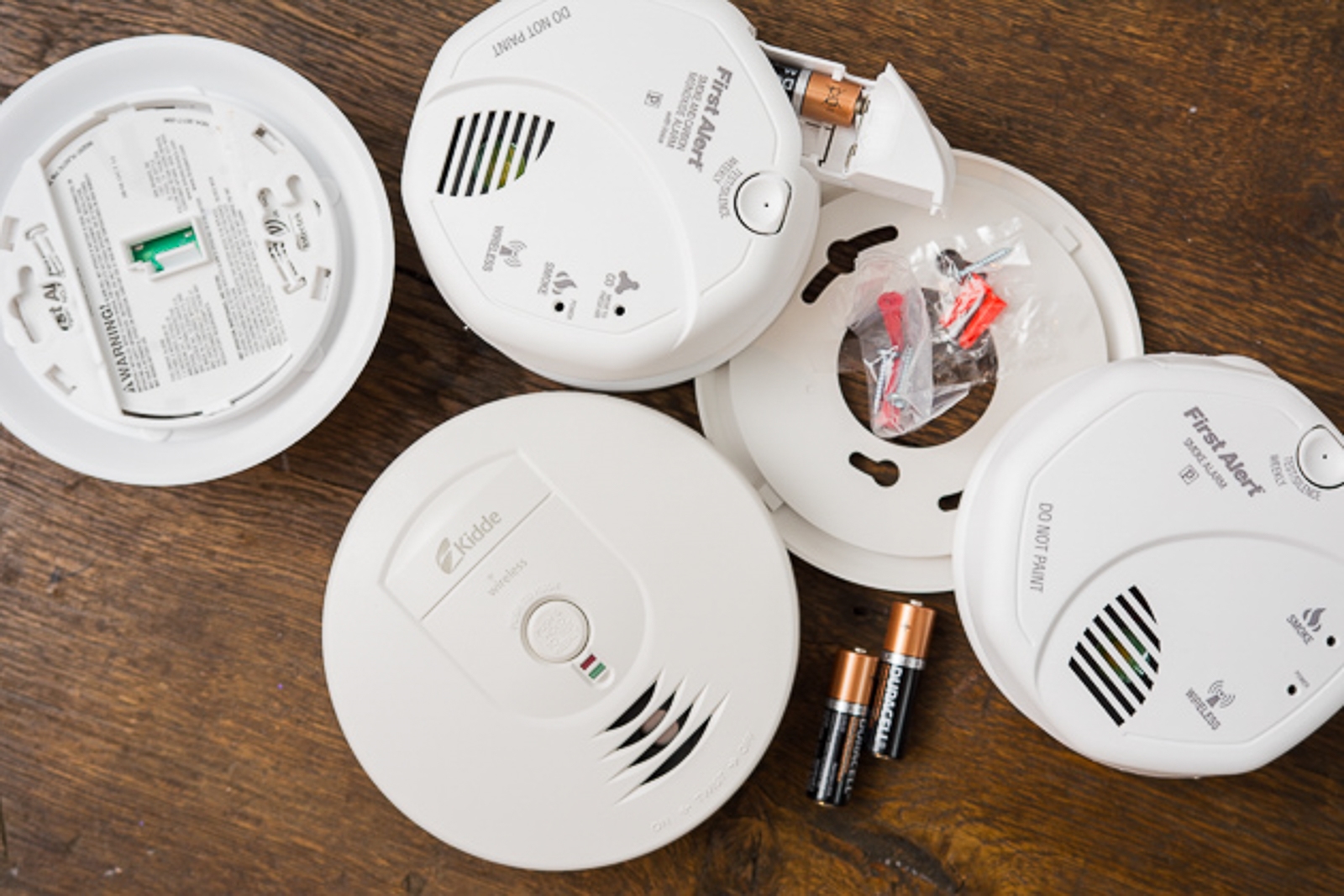
You can find two very distinct types of smoke alarms: ionization and photoelectric. Each sensing technology has its advantages, and as training coordinator and fire safety educator Tom Kiurski told us, “I recommend you have both types in your home.” This is also the official position of the NFPA and UL (PDF).
Ionization alarms are less expensive and less effective, but these alarms are what most people have. Ionization alarms contain a minuscule amount of radioactive material (americium-241) that ionizes oxygen and nitrogen atoms in the air, a process that creates a small electrical current in the sensing chamber. The alarm monitors this current, and when smoke enters the chamber, the current is disrupted and the alarm sounds. Such alarms detect very small particles, so they are good at sensing fast-burning, flaming fires.
Photoelectric sensors are set off when smoke enters the alarm and deflects the light of an LED beam onto a photocell. For slow, smoky, smoldering fires, photoelectric alarms are far more sensitive and effective. They’re slightly less effective than ionization models at sensing fast, flaming fires—but the difference in performance is small enough to tilt us toward a photoelectric model as our primary choice and an ionization model as a supplementary alarm.
A number of studies have quantified the two alarm types’ differences in response time. For one news report, the NBC affiliate for Dallas–Fort Worth simulated a smoldering couch fire with a variety of smoke alarms placed 15 feet away. The two photoelectric alarms sounded at just under 20 minutes, whereas the two ionization alarms sounded at 22 minutes and 28 minutes. According to the fire marshal supervising the test, by the time the second ionization alarm went off, the fire was at the “free-burning stage [when] it was completely unsurvivable.”
On fast-burning, flaming fires, a study conducted by UL and the Fire Protection Research Foundation found that ionization alarms responded about 30 seconds faster than photoelectric alarms on average. Thirty seconds may not sound like much, but a home can reach “untenable conditions” in just three minutes, according to a National Institute of Standards and Technology study (PDF). You’re likely to have less time to escape in a fast-spreading fire, so those 30 seconds can be crucial to your survival. As UL consumer safety director John Drengenberg told us, “You never know what type of fire will occur.” In other words, ionization alarms play an important part in a complete system.
Considering that both sensor styles have their benefits, you might conclude that your best bet is a dual-technology alarm, which has both ionization and photoelectric sensors in a single unit. But there’s a good reason not to rely entirely on dual-sensor smoke alarms. Ionization sensors are prone to nuisance alarms, mostly from cooking and shower steam, and people often disable them over that kind of annoyance. So while Joseph Keenan, assistant fire marshal in Burlington, Vermont, recommends that both types of alarm should be present in a home, in our interview he made sure to specify that they should be installed as “separate devices … not as dual-sensor devices.” He explained further: “If nuisance alarms occur with the ionization sensor, residents will take down the device and be left without detection.” Splitting the two types of sensors allows you to place each one in an ideal location.
Research backs Keenan up on the problem of disabled alarms. A study of smoke alarms in rural Alaskan homes found an “8-fold higher incidence of nuisance alarms in homes with ionization alarms.” In addition, the same study found that, due to nuisance alarms, “ionization smoke alarms were almost 5 times more likely to be disconnected 6 months after installation compared with photoelectric alarms.” A Texas A&M study that took into account disabled alarms concluded that “the probability of a fatality was 19.8% with ionization alarms [exclusively] but only 3.99% with photoelectric alarms.” Given those stats, it’s easy to see why Keenan told us that “resident behavior is the biggest challenge we face with smoke alarms.” This is also the reason the International Association of Fire Fighters, the largest firefighter union in the world, supports legislation (PDF) making photoelectric alarms a mandatory requirement for fire and building codes.
One way to increase the fire protection of your home is to get interconnected smoke alarms, so that when one goes off, they all do. Keenan referred to this as “the biggest feature which makes a smoke alarm effective.” The main advantage is that such an arrangement allows for “early notification of all residents within the dwelling, no matter where the problem originates.”
Current building code requires interconnected, hardwired smoke alarms with a battery backup in all new construction. Retrofitting this kind of wiring into a house is expensive, so now some new battery-powered smoke alarms can use a basic wireless technology to link the units. Overall, our research convinced us that recommending interconnected models should be a main focus of this guide.
We wanted to find models that would be affordable and accessible for anyone, so we looked primarily at basic or “dumb” models that run on AA batteries. (We have more to say on batteries in the Maintenance section.) Smart smoke alarms usually cost more than twice the price of our pick here (and that cost compounds when you need to purchase multiple units). When it comes to actual smoke- and fire-detection abilities, the difference between the best smart alarms and the best dumb alarms is not significant enough to be a dealbreaking factor. The major difference is that smart models allow you to monitor your home’s smoke alarms remotely via an app. Beyond that capability, smart smoke alarms offer additional features and smart-home integration. To learn more, see our separate guide to the best smart smoke alarm.
Some other basic models have a number of features that we didn’t prioritize, such as lights or specific alert noises. Those are nice, but as training coordinator and fire safety educator Tom Kiurski told us, “The options are what drive up the price.” He added that “having plenty of working smoke alarms is most important.”
Regardless, we suggest learning about your state and local smoke alarm regulations before making a purchase. We discovered that many are at odds with one another, and with our recommendations. No company sells a one-size-fits-all smoke alarm capable of satisfying the requirements of every state. First Alert has a nice interactive map that can help you get started on understanding your state’s requirements. We also recommend contacting your local fire department for more information specific to your area.
Our pick
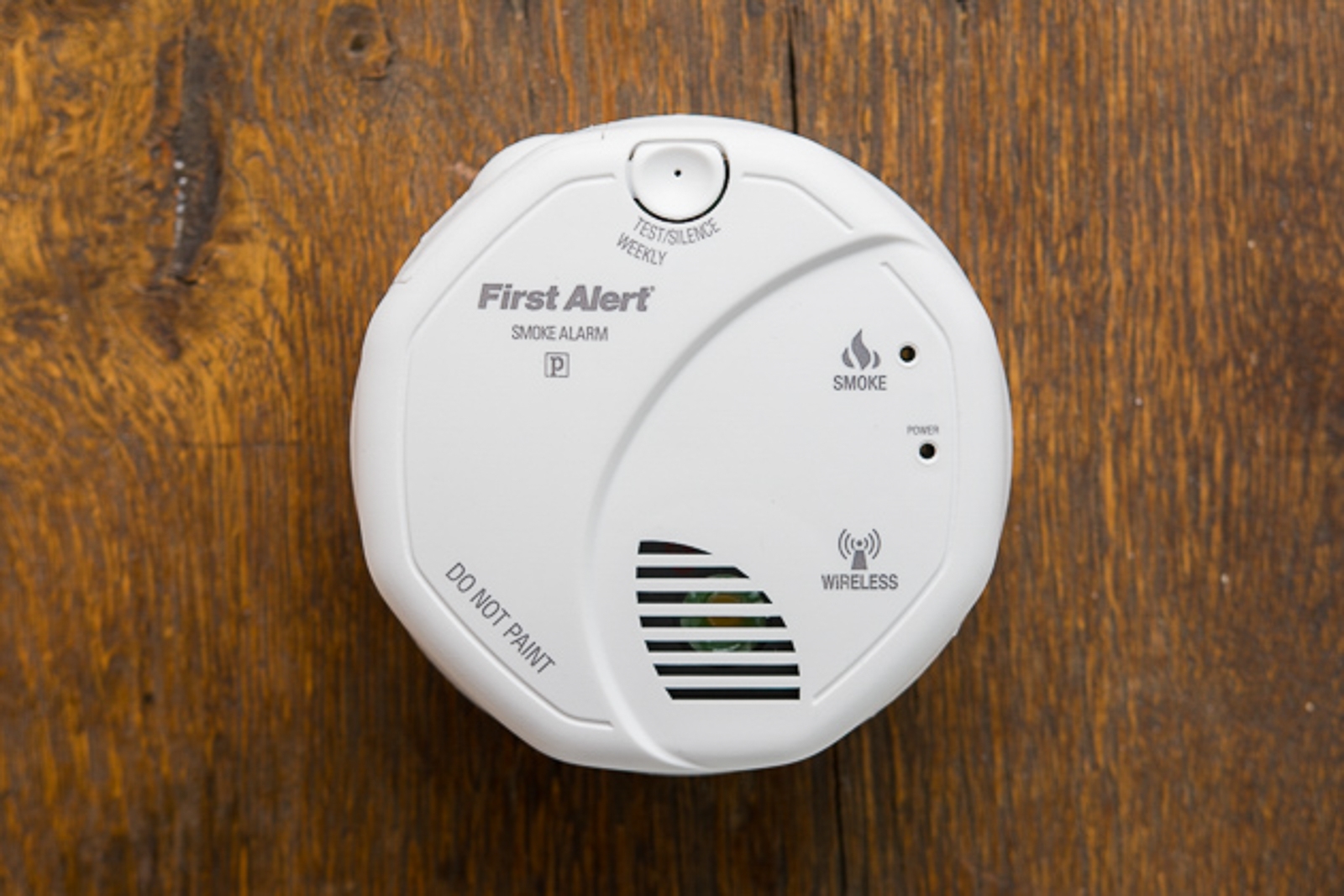
For your primary line of defense, we recommend the First Alert SA511CN2-3ST Smoke Alarm with Voice Location. This model is a photoelectric alarm, so it’s effective against both slow-burning, smoldering fires and fast-burning, flaming fires. It’s sold in a two-pack, and the two units can link together through a wireless signal and combine with additional units so that they all sound at once. In addition, you can set each unit to a location, so when an alarm goes off, all of the units indicate which room the fire is in. It’s a voice alarm, too, which experts say is more effective in waking small children than a simple tone. This model is the only alarm we found that combines the voice alarm, the location feature, and the wireless connection all in one unit—at a price that’s merely on the high side of average for the category.
The wireless connection is the most important feature for early detection of a fire. Upon installation, the alarms connect to one another with just a couple of button pushes on your part. As for range, First Alert says that each one has a limit of about 50 feet, although “[s]ome features of a home, such as the number of floors, number/size of rooms, furniture and types of building materials used may reduce the range of the alarms.” The company gives examples such as “suspended ceilings, ductwork, large metallic appliances (refrigerators) and metal studs.”
These First Alert units use what is called a mesh network, meaning that the signal is not linear from one unit to the next. The benefit of this technology, according to First Alert, is that “the mesh network of alarms re-routes and resends the signal via the other alarms, providing a greater chance all alarms will receive the signal.” It’s important to note that these alarms are connected only to one another and have nothing to do with a phone app or a household Wi-Fi connection. You can expand the network to a maximum of 12 alarms.
Because they’re interconnected, the SA511CN2-3ST alarms not only give you an early warning but also tell you where the problem is originating from. During initial setup, you assign each alarm a room location. When the alarms go off, they all announce the source alarm’s location. As training coordinator and fire safety educator Tom Kiurski told us, “Vocal smoke alarms are recommended if you have children between 4 and 12 years of age, because studies show they respond better to a familiar voice, as opposed to something that can fall under ‘white noise.'”
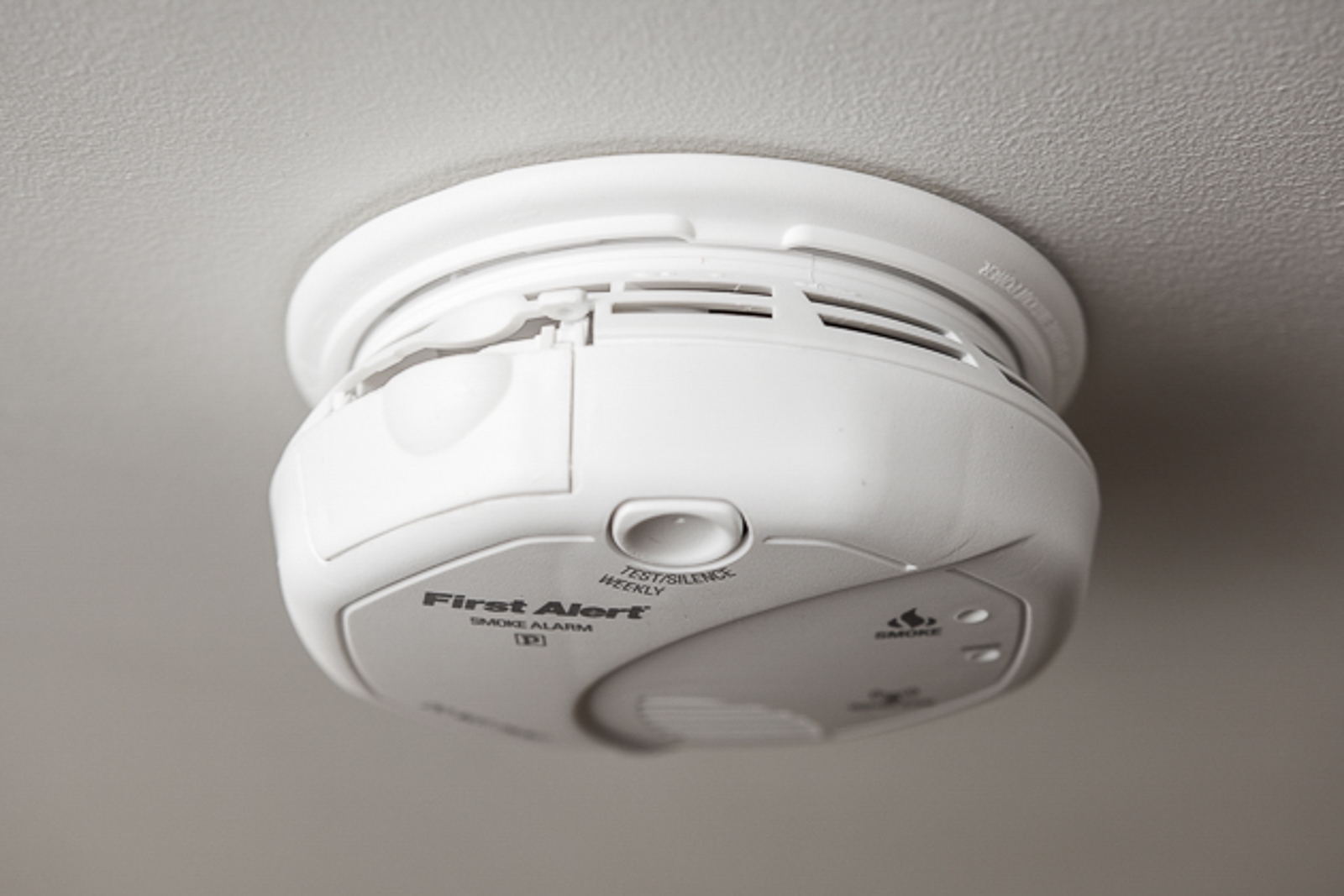
At Amazon, the SA511CN2-3ST two-pack has ranged from $50 to about $130 but has spent most of the time around the $70 to $80 mark, so each unit usually costs around $35 to $40. As a result, this model is slightly more expensive than a standard battery alarm, which is typically $25 or less. Given this model’s unique combination of features—you get a connected photoelectric alarm system with location and voice alerts—we think it’s worth the added cost.
We recommend using these First Alert alarms as your principal line of defense, with one on each floor and one in each bedroom, adding more to account for the size of your house. We also believe it’s important to have a carbon monoxide detector as well as an ionization alarm on each floor for added protection against the hazards they’re suited for, and we have suggestions on those below.
Flaws but not dealbreakers
The main downside to our First Alert pick is that the wireless units are available only with photoelectric sensors—none of the company’s ionization alarms have wireless connectivity. For maximum protection against both fast-burning, flaming fires and slow-burning, smoldering fires, your home needs both types of sensor. The best-case scenario is that they’re all linked to the same system, but that isn’t possible with First Alert.
First Alert’s primary competitor (the only other major smoke alarm manufacturer) is Kidde. That company has the opposite problem: Its wireless system offers only ionization alarms and no photoelectric ones (we’re talking only about non-app-based wireless systems here). So to have both styles of sensor on a wireless connection, you need to have two separate systems in your house. Our recommendation for the Kidde wireless ionization alarm is below.
Another drawback of the First Alert SA511CN2-3ST units is that they’re not particularly attractive. They look like, well, smoke alarms. First Alert has other models with a much more streamlined look (such as the P900), but to get the wireless connectivity, the photoelectric sensor, and the voice/location alerts in a single unit, your only option is the one we’re recommending. The good news is that once smoke alarms are installed, everyone stops noticing them.
Same but with a carbon monoxide detector
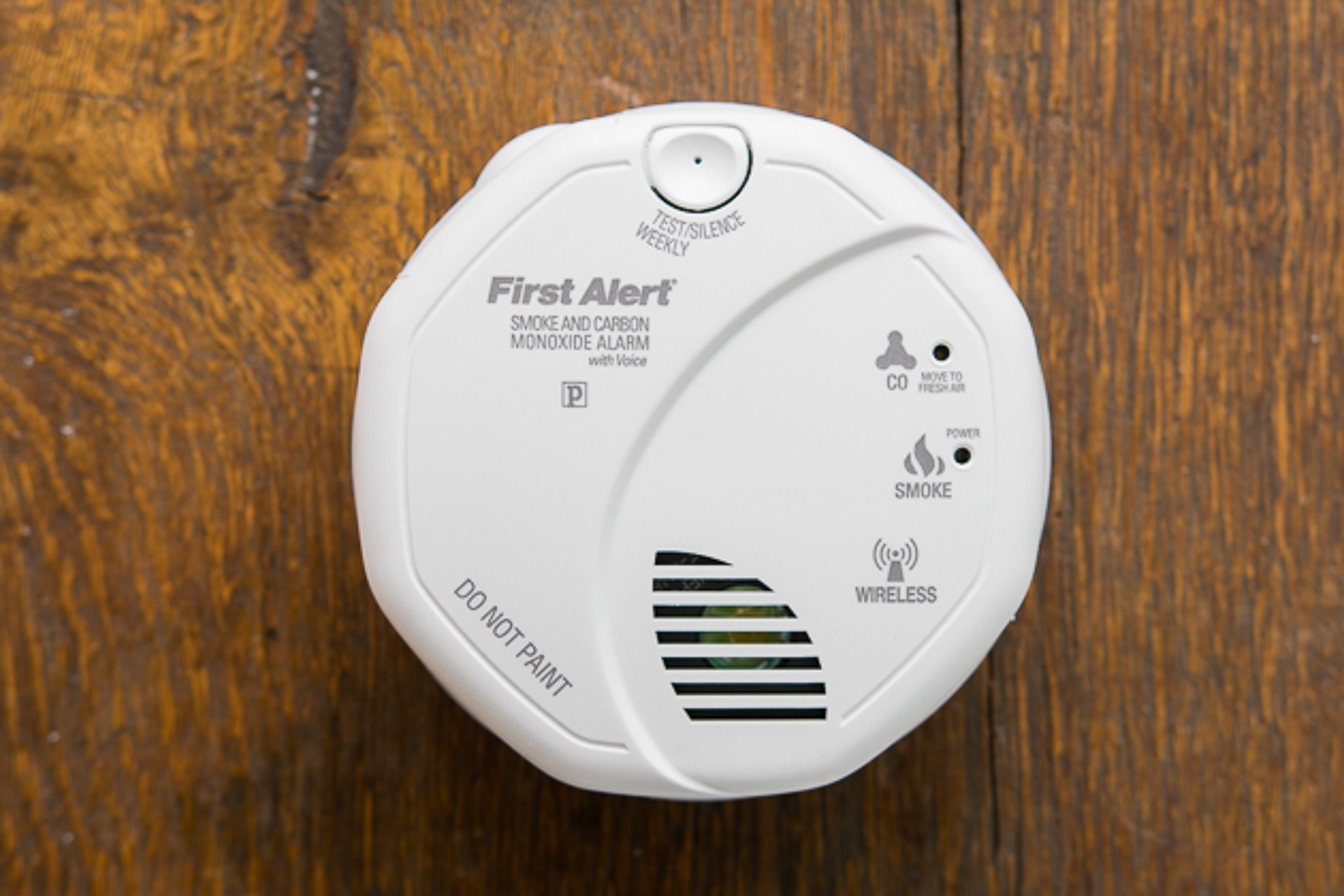
Carbon monoxide is a deadly, odorless, colorless gas that can spread through a home as the result of a malfunctioning or improperly installed combustion appliance such as a gas stove, a gas boiler, a water heater, a propane range, or a wood stove. If you don’t already have CO alarms, we strongly recommend including a few First Alert SCO501CN-3ST Combination Smoke and Carbon Monoxide Alarm with Voice Location units in your interconnected system.
This model offers the same features as our main pick (photoelectric sensor, wireless interconnectivity, voice alarm, and location alerts) and adds a carbon monoxide sensor. That CO detector adds a good bit to the price—currently a single SCO501CN-3ST unit is just barely cheaper than the two-pack of our top pick—so we made this a separate recommendation in case you’re already covered with a stand-alone CO detector.
A more limited wireless option
If the First Alert SA511CN2-3ST is unavailable or if the price jumps too high, we also like the First Alert SA501CN2-3ST Smoke Alarm, which has the same interconnectivity feature and photoelectric sensor. The drawback is that this model does not have the voice or location features. Unfortunately, you won’t pay much less for the more limited features: First Alert’s store has this model priced just a bit lower than our main pick, and we found that many retailers have it in the same range. Like our main pick, this model comes in a two-pack.
One to add for extra protection
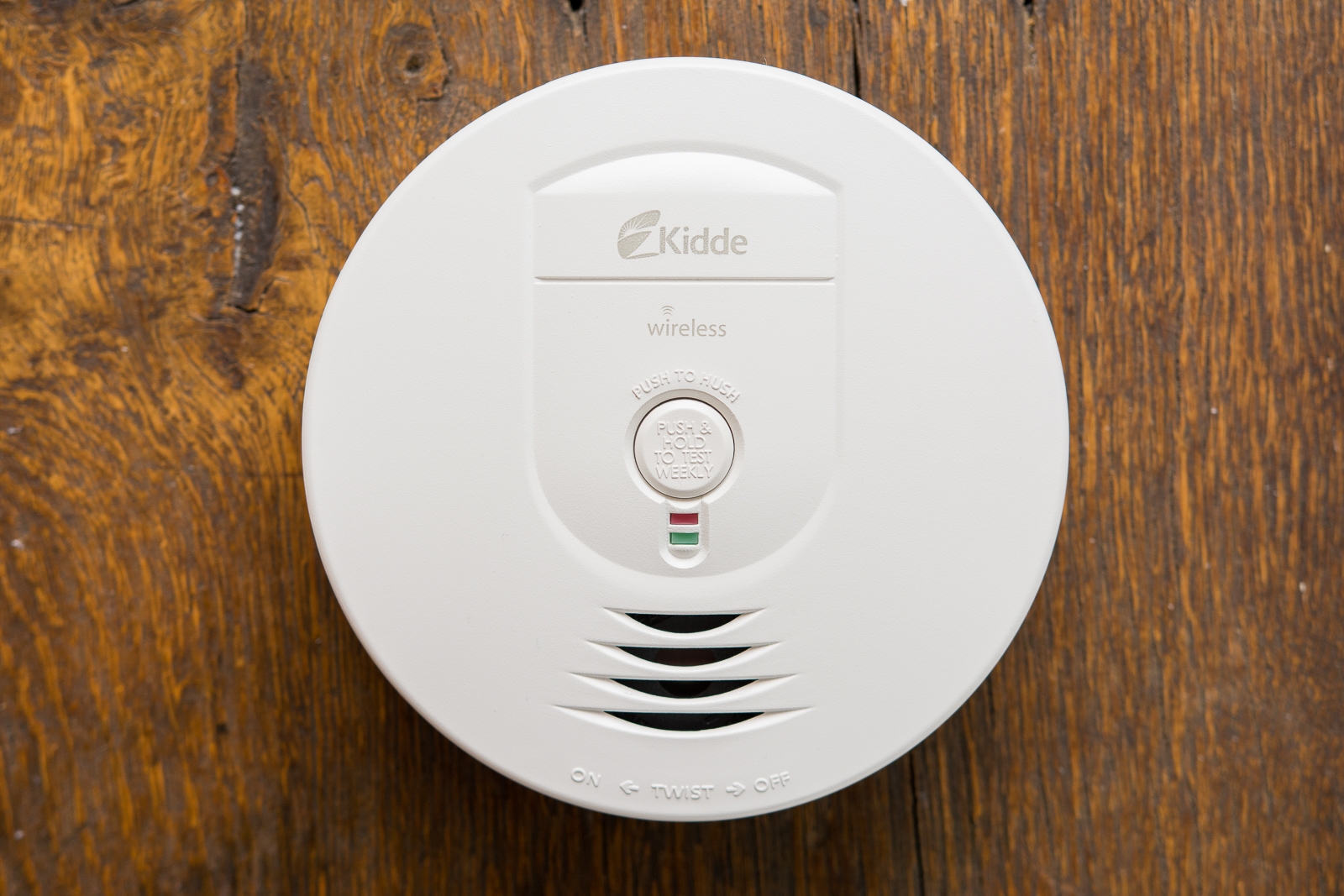
For an added level of protection against fast-burning, flaming fires, we recommend that you also have a Kidde RF-SM-DC Wireless Interconnected Smoke Alarm on each floor (it’s also available in a three-pack). This model is an ionization alarm, the kind that studies have shown reacts slightly faster to quick-spreading, flaming fires. The downside is that ionization sensors aren’t nearly as good at detecting slow, smoky fires, and they’re also prone to nuisance alarms, mostly from cooking or shower steam. Studies have shown that with repeated nuisance alarms, a home’s residents are more likely to disable the alarm. It’s for these reasons that we recommend using this Kidde model only as a supplement to our main pick and not as a primary smoke alarm. Because this alarm operates on a wireless technology, similar to the First Alert models, you can interconnect multiple units of this Kidde model to one another (but not to the First Alert models). It also has a hush button in the event of a nuisance alarm.
Where to install smoke alarms
The National Fire Protection Association’s recommendation for smoke alarm placement is that you have one on each floor and one in each bedroom. So for a typical two-story home, that’s one in the basement (preferably near the stairs to the first floor), one on the first floor, and one in the second-floor hallway, with an additional unit in each bedroom or sleeping area. You should not place one in a garage (due to car exhaust) or in areas that have temperatures lower than 40 degrees Fahrenheit or higher than 100 degrees Fahrenheit.
As for the specifics of smoke alarm location within a room, there are actually quite a few areas to avoid. First Alert’s FAQ states, “Install your alarms at least 20 feet from appliances like furnaces and ovens, which produce combustion particles. Alarms should be at least 10 feet from high humidity areas like showers and laundry rooms, and at least 3 feet from heat/AC vents.” In a response to a nuisance-alarm question at the Home Depot website, a representative from Kidde mentions other areas to be wary of, including near a “ceiling paddle or whole house ventilating fans, or other high air flow areas.” The rep continues, “Avoid putting the alarms near fluorescent lights, amateur radios, electrical equipment or other devices known to transmit an RF signal. Electronic ‘noise’ may cause nuisance alarms. Avoid large metal surfaces and bundles of wire.”
Maintenance
It’s important to check your smoke alarms on a regular basis. Training coordinator and fire safety educator Tom Kiurski recommends doing so monthly and says to “change the battery as suggested by the manufacturer.” According to the NFPA, “Manufacturers’ instructions are specific to the batteries (brand and model) that must be used. The smoke alarm may not work properly if a different kind of battery is used.” Our picks all take AA batteries, but the instructions for the Kidde model we recommend are quite specific, saying you should use only Energizer E91, Duracell MN1500, or Duracell MX1500 batteries.
Don’t use rechargeable batteries: The manual for the First Alert SA511CN2-3ST (PDF) says to “[n]ever use rechargeable batteries,” and none of the batteries that Kidde recommends are rechargeable.
As for how often you should replace the batteries, the information we found errs on the side of caution. First Alert recommends putting new batteries in twice each year, specifically “when you change your clocks for daylight saving time.” That might sound excessive, but as Consumer Reports explains, “You have installed those smoke alarms in order to stay safe, and the battery-change schedule is conservative because of an abundance of caution.” The CR article adds, “If you think that your alarm’s old battery has some ‘life’ left, use it in a product that doesn’t have to do with safety.” Most alarms start to chirp when the batteries are low—make sure not to treat such sounds as nuisance alarms and ignore them.
If you’re looking for longer battery life, some smoke alarms now have 10-year sealed lithium batteries, but our research shows that these models usually aren’t as great as they seem. One purported benefit is that they offer a higher degree of tamper resistance because the battery is not removable. But when you take the unit off the wall, it deactivates. Such alarms also require testing on a regular basis. According to the NFPA, the Centers for Disease Control and Prevention did a long-term follow-up on alarms with lithium ion batteries and found that 14 percent had dead batteries before the full 10 years were up. For us, it was a moot point: Currently no wireless alarm models have a 10-year sealed battery. (If any models had offered such a thing at the time of our research, we would have considered them alongside the rest.)
Finally, it’s important to know the age of your smoke alarm. Tom Kiurski told us that alarms need replacing “after ten years of age.” He continued, “You can find out when your alarm was made by looking at the unit itself. It is required by law to be on there since the year 2000.” He said that if a smoke alarm has no printed date, it was made before 2000 and should be replaced.
The competition
Aside from our picks, no other alarms combine wireless interconnectivity with a photoelectric sensor and voice and location alerts. This includes all other alarms from First Alert and Kidde, the two largest manufacturers of residential smoke alarms. Among ionization alarms, only Kidde has a model with wireless connectivity. If more become available, we’ll consider them and update this guide.
We did find alarms from Universal Security Instruments that use a third smoke-detecting technology called IoPhic, which is proprietary to the company and appears to be a form of ionization alarm designed to reduce nuisance alarms. The technology looks good on paper (PDF), but none of our experts mentioned it (Firehouse Magazine’s Timothy Sendelbach was unfamiliar with it), and the customer reviews at Amazon are generally poor. The alarms are UL-approved. It’s a relatively new technology, and we will be keeping an eye on it as it gets a foothold in the industry.
In the future, we expect the gap to narrow between smart smoke alarms and wireless, interconnected (but not app-connected) basic models like our pick in this guide. Smart alarms can offer valuable additional features—but at more than double the price, they can be far more expensive than our picks, especially when you’re outfitting an entire house with multiple units. For future updates to this guide, we will consider smart alarms alongside the more feature-rich basic units, and as the devices evolve, we will make the call as to which alarm gives you the most protection at the best value.
This guide may have been updated by Wirecutter. To see the current recommendation, please go here.
Note from Wirecutter: When readers choose to buy our independently chosen editorial picks, we may earn affiliate commissions that support our work.
(58)

